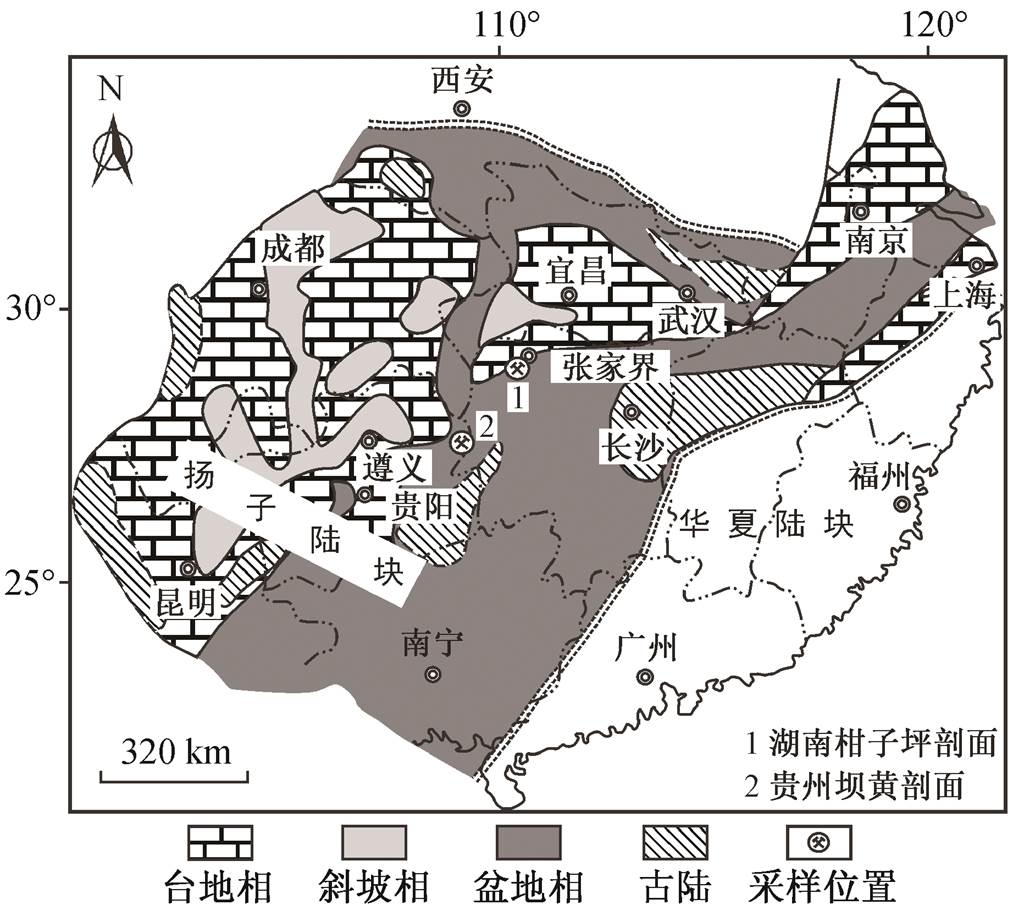
图1 扬子地块前寒武纪‒寒武纪转折期古地理图[18]
Fig. 1 Paleogeographic map of Yangtze Block during the Ediacaran-Cambrian transition[18]
魏帅超1, 2 陈启飞3 付勇1,4,† 崔滔5 梁厚鹏1 葛枝华1 张鹏1 张勇6
1. 贵州大学资源与环境工程学院, 贵阳 550025; 2. 中国地质科学院水文地质环境地质研究所, 石家庄 050061; 3. 贵州省地质调查院, 贵阳 550018; 4. 中国地质科学院矿产资源研究所, 北京 100037; 5. 贵州理工学院资源与环境工程学院, 贵阳 550003; 6. 江苏省电力设计院, 南京 211102; †通信作者, E-mail: byez1225@126.com
摘要 对埃迪卡拉纪‒寒武纪之交的贵州铜仁坝黄剖面留茶坡组层状硅质岩和湖南张家界柑子坪剖面留茶坡组穹隆状硅质岩的主量、微量元素和稀土元素以及Ge/Si特征进行分析, 探讨两种硅质岩的成因。层状硅质岩的SiO2含量为96.06%~99.61%, 穹窿状硅质岩的SiO2含量为98.62%~99.56%, 平均值为99.13%; 其他元素含量很低, 两者均为纯硅质岩。坝黄层状硅质岩的∑REE为20.14~248.56μg/g (平均100.62μg/g), Eu/Eu*值为0.90~1.10(平均1.06), 无明显异常, Ge/Si值为0.13~0.98 μmol/mol(平均0.50 μmol/mol), Al2O3与∑REE明显正相关, 表明硅质岩成分明显受陆源输入的控制。柑子坪穹隆状硅质岩的∑REE值低,为3.75~7.24μg/g(平均5.73μg/g), Ce/Ce*值为0.46~0.66(平均0.57), 具负异常, Eu/Eu*值为2.28~11.07(平均4.60), 具明显正异常, Ge/Si值为1.09~1.43μmol/mol(平均1.25μmol/mol), Al2O3与∑REE的相关性较差, 表明硅质岩为海底热液成因。Al2O3与Ge/Si的相关性强弱也可以反映硅质岩的来源。结合古地理环境, 推断层状硅质岩可能形成于盆地内部,而穹隆状硅质岩可能发育在台缘同生断裂处, 因海底热液喷流而形成。以1μmol/mol 作为Ge/Si的临界值可以为示踪硅质岩的物质来源提供新的思路。
关键词 留茶坡组; 层状硅质岩; 穹隆状硅质岩; Ge/Si; 热液
埃迪卡拉纪‒寒武纪之交是地质历史上重要的转折时期, 发生了新元古代氧化和寒武纪生命大爆发等重大事件[1–4]。在该转折期, 海洋中极其富集硅和铁[5], 在塔里木盆地及扬子地块大规模发育硅质岩, 尤其在扬子地块深水区和斜坡区发育连续的硅质岩层[6]。以硅质岩为主的连续地层为了解埃迪卡拉纪‒寒武纪转折期的重大事件提供了一个良好的窗口。前人采用多种地球化学方法探究硅质岩的成因, 其中同位素方法有 δ30Si 值判别法[7]和 δ30Si-δ18O 图解法[8], 主量元素判别方法有 Al/(Al+Fe+ Mn)比值法和 Al-Fe-Mn 三角图解法[9], 稀土元素特征判别方法有 La/Ce-Al2O3/(Al2O3+Fe2O3)图解法[9]、稀土配分模式、轻重稀土比值法、Ce/Ce*比值法和Eu/Eu*比值法[9–10]。
研究发现, Ge/Si值可以有效地示踪硅质岩的物质来源[11–16],如利用条带状含铁建造(banded iron formations, BIF)中的 Ge/Si 值示踪前寒武纪海洋中溶解性 SiO2的来源[11–12,15–16], 示踪埃迪卡拉系陡山沱组硅质岩和埃迪卡拉系‒寒武系界线附近老堡组硅质岩的来源[13–14]。Ge/Si 值还可以示踪风化作用的强度[14]。
本文以贵州铜仁坝黄剖面留茶坡组层状硅质岩和湖南张家界柑子坪剖面留茶坡组穹隆状硅质岩为研究对象, 运用 Ge/Si 示踪法, 并结合其元素地球化学特征, 探讨这两种硅质岩的成因。
扬子地块以太古宇深变质岩系及古元古界浅变质岩系为结晶基底, 在震旦纪早期形成以碳酸盐台地为主的浅海相沉积相, 地块内部及周缘表现为大规模拉张裂陷作用, 形成若干近EW向和NN向的张性断层, 同时也形成南华裂谷盆地等多个裂谷盆地[17]。震旦纪晚期, 由于受罗迪尼亚超大陆裂解活动的影响, 地层出现差异性抬升, 正地貌发育碳酸盐台地, 负地貌形成富硅质盆地。寒武纪早期, 海平面迅速上升, 原有的大部分碳酸岩台地及硅质盆地被陆源碎屑沉积覆盖, 形成西北高、东南低的以含磷硅泥岩和黑色页岩沉积为主的开阔陆源碎屑陆棚, 超覆在灯影组白云岩和同层位的留茶坡组硅质岩之上, 扬子地块形成以台地相、斜坡相及盆地相组合的沉积相变化格局(图 1)。不同沉积相区发育类型不同的硅质岩, 反映当时古海洋变化和沉积作用的特点。从湖南张家界的柑子坪台缘过渡相至贵州铜仁的坝黄深水斜坡相, 硅质岩地层向盆地方向从薄变厚, 白云岩则快速减薄(图 2)。从区域上看, 张家界柑子坪剖面位处同生断裂带上[20]。
坝黄剖面出露的地层: 新元古界板溪群、大塘坡组黑色页岩、南沱组冰碛岩、陡山沱组炭质泥岩及白云岩、留茶坡组硅质岩及页岩, 下寒武统牛蹄塘组黑色页岩、变马冲组灰岩、杷榔组碎屑岩及清虚洞组白云岩, 中、上寒武统灰岩及白云岩, 奥陶系白云岩和页岩以及第四系。柑子坪剖面出露的地层: 新元古界板溪群变泥质岩, 下寒武统牛蹄塘组黑色页岩、清虚洞组白云岩, 中、上寒武统灰岩及白云岩, 奥陶系白云岩及页岩。
取样位置见图 2。穹隆状硅质岩呈浅灰色至黑灰色, 穹隆状或丘状, 矿物成分主要为隐晶质的硅质。在保存较好的穹窿状硅质岩中可见不规则凝块状内部结构(图 3(a))。穹窿状硅质岩表面有大量气孔和空洞, 常被纤维状玉髓、放射状微晶石英或白云石充填。层状硅质岩呈灰色至灰黑色, 薄层至中厚层状, 局部呈厚层状(图 3(b))。矿物成分主要为含量超过 90%的玉髓及隐晶‒微晶石英, 其次为泥质、白云质及少量黏土矿物等, 隐晶质结构。由于炭泥质、磷质的分布不均匀, 硅质岩呈现深浅不同的条带, 部分层段见凝灰岩夹层。

图1 扬子地块前寒武纪‒寒武纪转折期古地理图[18]
Fig. 1 Paleogeographic map of Yangtze Block during the Ediacaran-Cambrian transition[18]
样品Bh-19~Bh-24取自坝黄剖面留茶坡组层状硅质岩, GZP04, GZP04C, GZP04CR-1 和 CZP04CR-2取自柑子坪剖面留茶坡组上部穹隆状硅质岩。在中国地质科学院国家地质实验测试中心采用激光剥蚀电感耦合等离子质谱仪(LA-ICP-MS), 对样品的主量、微量元素及稀土元素进行测定。所用仪器为Thermo Element Ⅱ等离子质谱仪, 激光剥蚀系统为New Wave UP-213。剥蚀物的载气为He, 激光波长为213 nm, 束斑为40 um, 脉冲频率为 10 Hz, 能量为 0.176mJ, 密度为 23~25J/m2。测试过程中, 首先要遮挡激光束, 目的是采集空白背景 15 秒, 然后对样品进行连续剥蚀采集 45 秒, 停止剥蚀后继续吹扫15 秒, 清洗进样系统。所以, 单点测试时间为 75秒。等离子质谱测试参数: 冷却气(Ar)流速为 15.55 L/min, 载气(He)流速为 0.58 L/min, 样品气流速为0.819 L/min, 辅助气(Ar)流速为 0.67 L/min, 射频发生器功率为 1205 W。以 NIST-612 为外标进行样品测定。测试结果见表1。
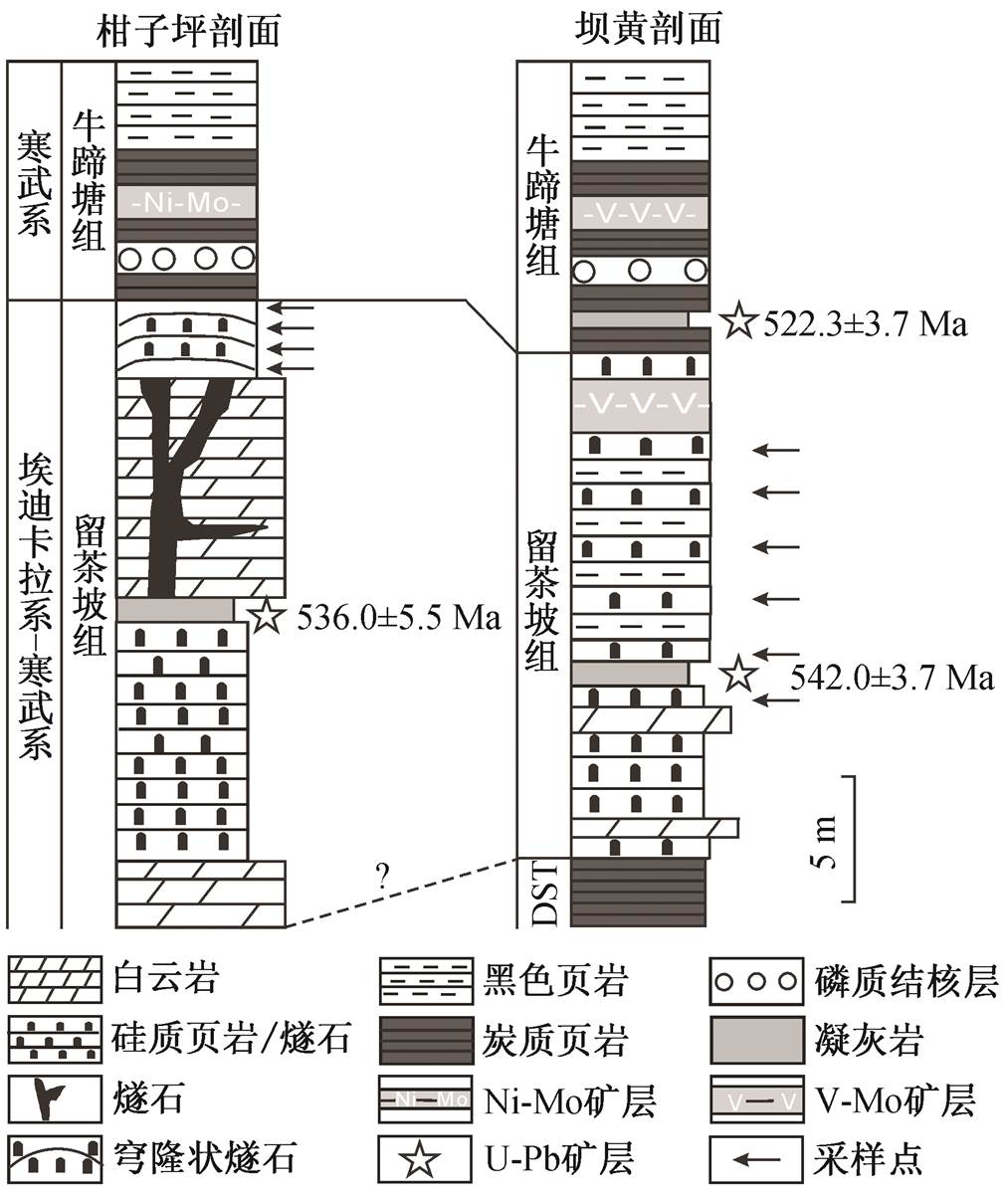
542.6±3.7和522.3±3.7 Ma来自文献[6], 536.3±5.5 Ma来自文献[19]
图2 柑子坪剖面与坝黄剖面地层对比及取样位置
Fig. 2 Stratigraphic diagram and sampling location in Ganziping section and Bahuang section
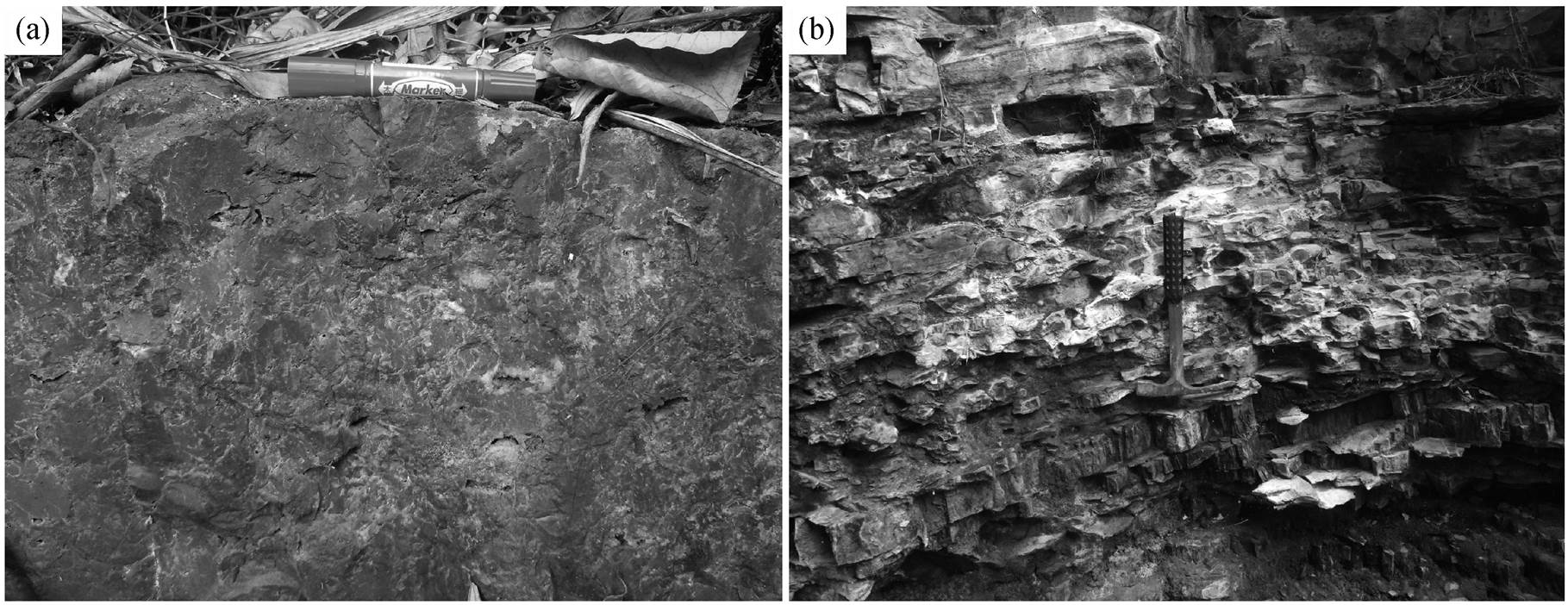
(a)湖南柑子坪剖面留茶坡组穹隆状硅质岩; (b)贵州坝黄剖面留茶坡组层状硅质岩
图3 留茶坡组硅质岩野外照片
Fig. 3 Field photos of mounded chert of Liuchapo Formation
从表 1 看出, 柑子坪剖面穹窿状硅质岩的 SiO2含量非常高(98.62%~99.56%, 平均 99.13%), Si/Al值均很高(172.48~ 614.57, 平均 260.06)。坝黄剖面的层状硅质岩的SiO2含量, 除样品 Bh-21 (85.73%)和Bh-24 (73.71%)外均较高(96.06%~99.61%); 坝黄剖面层状硅质岩的 Si/Al 值均较高(102.86~746.64, 平均 421.60, 只有样品 Bh-21 (44.54)和 Bh-24 (64.46)由于硅质含量低而黏土含量高导致比值较小。根据Murray 等[9]的标准, 纯硅质岩的 SiO2 含量在 91%~ 99%之间, Si/Al 值在 80~1000 之间, 所以可以判断这两种硅质岩均为纯硅质岩。柑子坪剖面硅质岩的Al2O3 含量为 0.17%~0.60%, 平均 0.40%。坝黄剖面硅质岩的 Al2O3 含量, 除样品 Bh-21 (2.02%)相对较高外, 其余样品在 0.14%~1.20%之间, 平均0.57%。两剖面硅质岩的 TiO2 及 MnO2 含量极低, 大部分样品小于 0.01% (坝黄剖面样品为 0.01%~0.12%)。坝黄剖面硅质岩的 Fe2O3, MgO 和 CaO 含量明显高于柑子坪剖面, 分别为 0.05%~1.00% (平均 0.45%)、0.05%~10.77% (平均 2.80%)和 0.08%~13.41% (平均3.42%)。两种硅质岩的 Na2O和 P2O5含量相近。
表1 坝黄剖面和柑子坪剖面埃迪卡拉系–寒武系界线过渡地层硅质岩主量和微量元素测试结果
Table 1 Maior element contents and trace element contents in siliceous rocks of Ganziping section and Bahuang section during the Ediacaran-Cambrian transition

续表
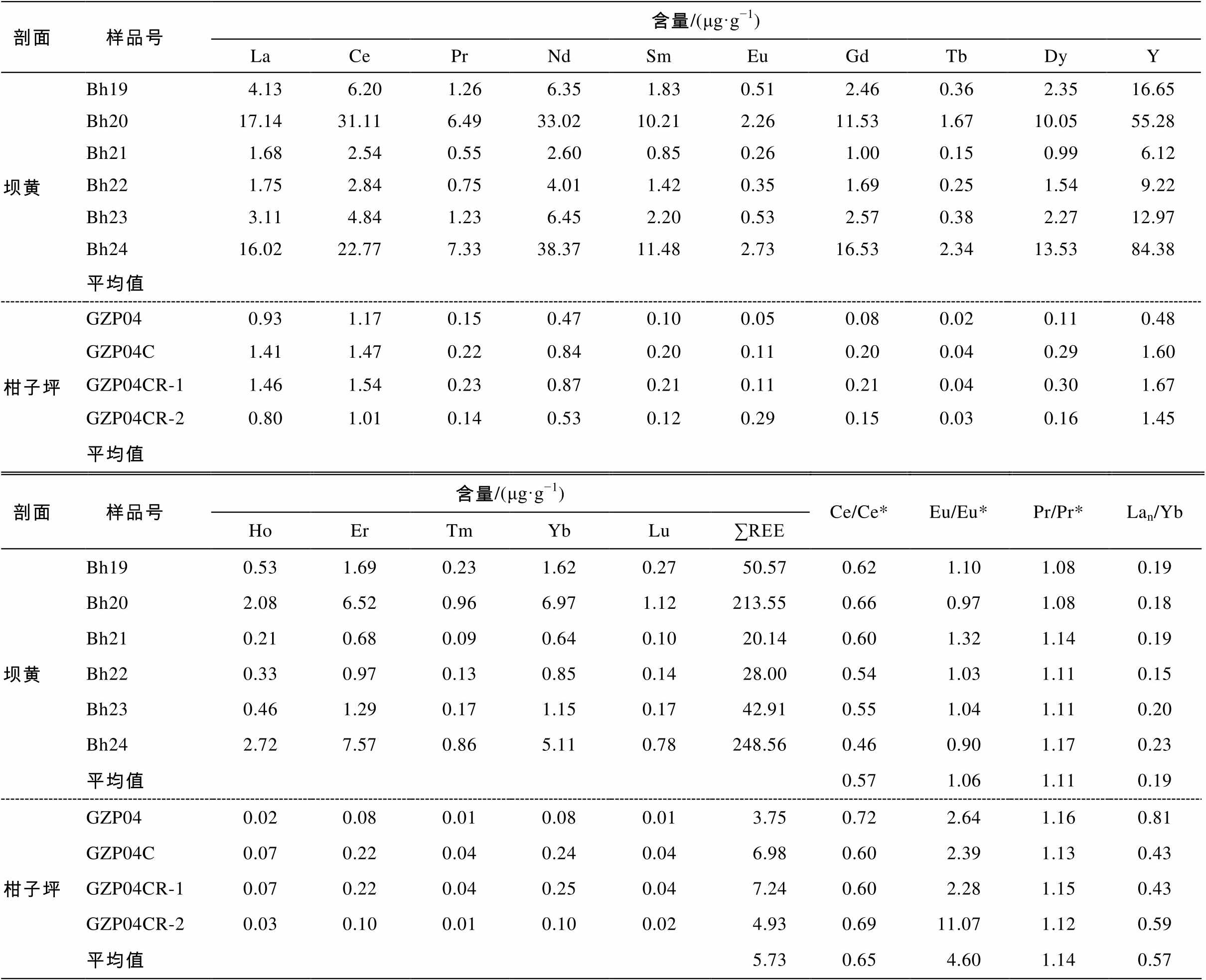
据 Adachi 等[21]和 Herzig 等[22]对海底热泉的研究, 热泉沉积物具有高SiO2和低Al2O3, TiO2, MgO的特征, 所以柑子坪穹隆状硅质岩中的硅质可能来源于热液。Adachi等[21]发现, 纯热液成因和纯生物成因硅质岩的 Al/(Al+Fe+Mn)值为 0.01~0.6, 并经过统计研究, 拟定出判别硅质岩成因的 Al-Fe-Mn三角图解。柑子坪剖面硅质岩的 Al/(Al+Fe+Mn)值为 0.64~0.90 (平均 0.77), 坝黄剖面硅质岩的 Al/ (Al+Fe+Mn)值为 0.48~0.75 (平均 0.62), 两种硅质岩大部分落在 Al-Fe-Mn 三角判别图解的非热液成因区域(图 4)。由于两个剖面的硅质岩均为纯硅质岩, Si 以外的其他元素含量很低, 可能会对用这种方法判别硅质来源的准确性产生一定的影响。
图5对比柑子坪剖面和坝黄剖面茶坡组硅质岩放入典型地球化学参数。由于柑子坪剖面和坝黄剖面均为纯硅质岩, 且石英晶体中匮乏稀土元素, 所以两者的∑REE 均较低。坝黄剖面样品的∑REE 为20.14~248.56μg/g, 平均 100.62μg/g; 柑子坪剖面样品的∑REE 更低(3.75~7.24μg/g, 平均 5.73μg/g)。柑子坪剖面样品的 Ce/Ce*值为 0.6~0.72 (平均 0.65), 具轻微的 Ce 负异常。坝黄剖面样品的 Ce/Ce*值为0.46~0.66 (平均 0.57), 显示明显的 Ce 负异常。柑子坪剖面样品的 LaN/YbN 值比较小(0.15~0.23, 平均0.19), 在稀土元素 PAAS 标准化图(图 6)中显示重 稀土富集; 坝黄剖面样品的 LaN/YbN 值稍大(0.43~ 0.81, 平均 0.57), 重稀土富集程度低(图 7)。柑子坪剖面样品的 Eu/Eu*值为 2.28~11.07(平均 4.60), 呈现明显的 Eu 正异常; 坝黄剖面样品的 Eu/Eu*值为 0.90~1.32(平均 1.06), 没有 Eu 的异常。柑子坪剖面硅质岩的稀土元素配分曲线轻微左倾, 坝黄剖面硅质岩的稀土元素配分曲线明显左倾。
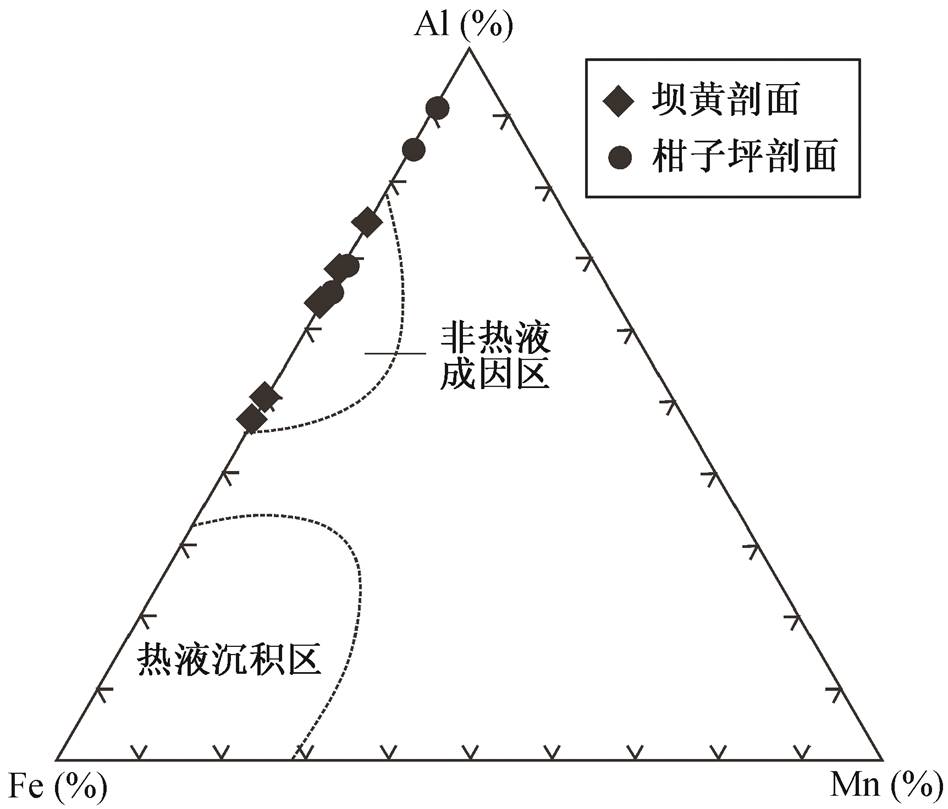
图4 柑子坪剖面和坝黄剖面留茶坡组硅质岩Al-Fe-Mn图解(底图据文献[21])
Fig. 4 Al-Fe-Mn diagram for the siliceous rocks of Liuchapo formation in Ganziping section and Bahuang section (after Ref. [21])
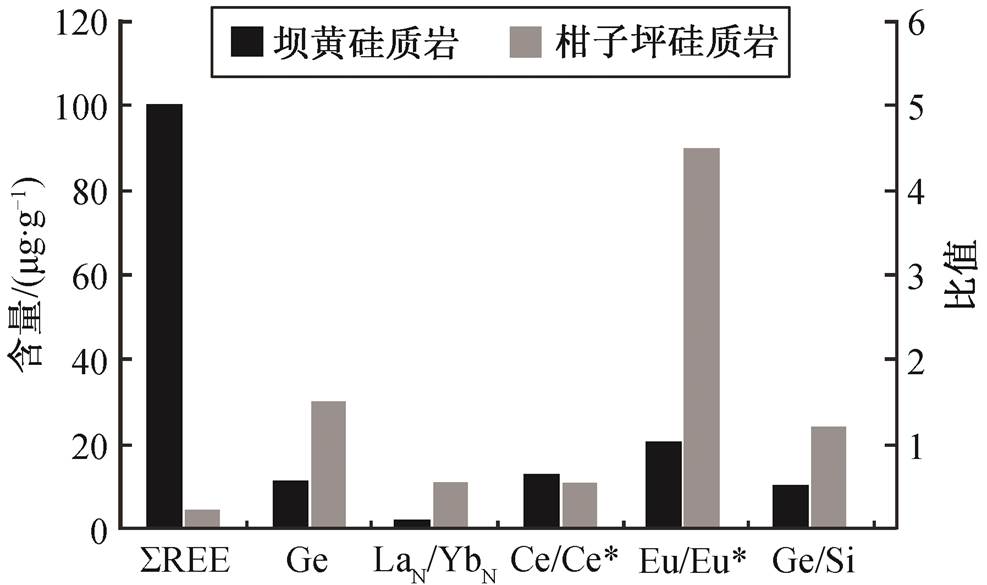
图5 柑子坪剖面与坝黄剖面留茶坡组硅质岩典型参数对比
Fig. 5 Comparison of typical parameters in the cherts of Liuchapo Formation between Ganziping section and Bahuang section
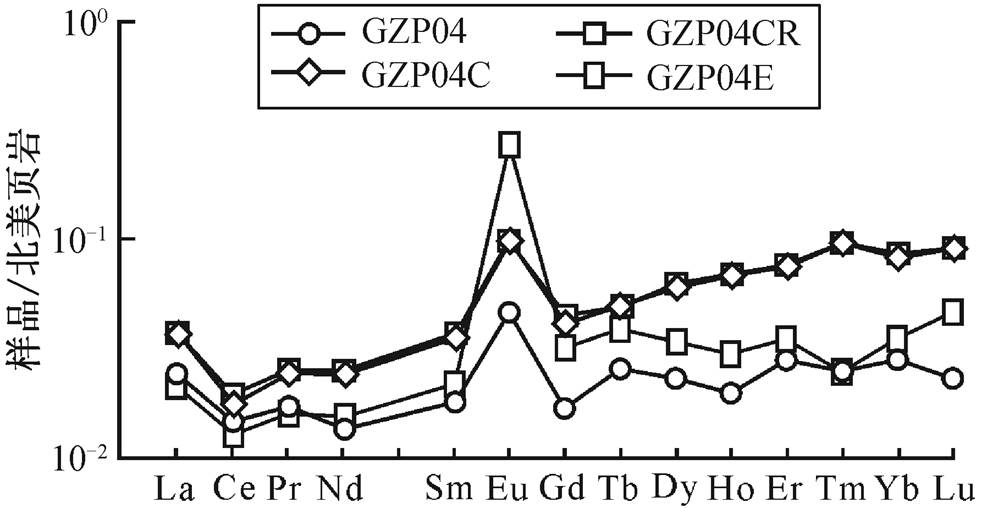
图 6 柑子坪剖面留茶坡组穹隆状硅质岩稀土配分模式(北美页岩数据引自文献[23])
Fig. 6 REE patterns of mounded chert of Liuchapo Formation in Ganziping section (PAAS data is from Ref. [23])
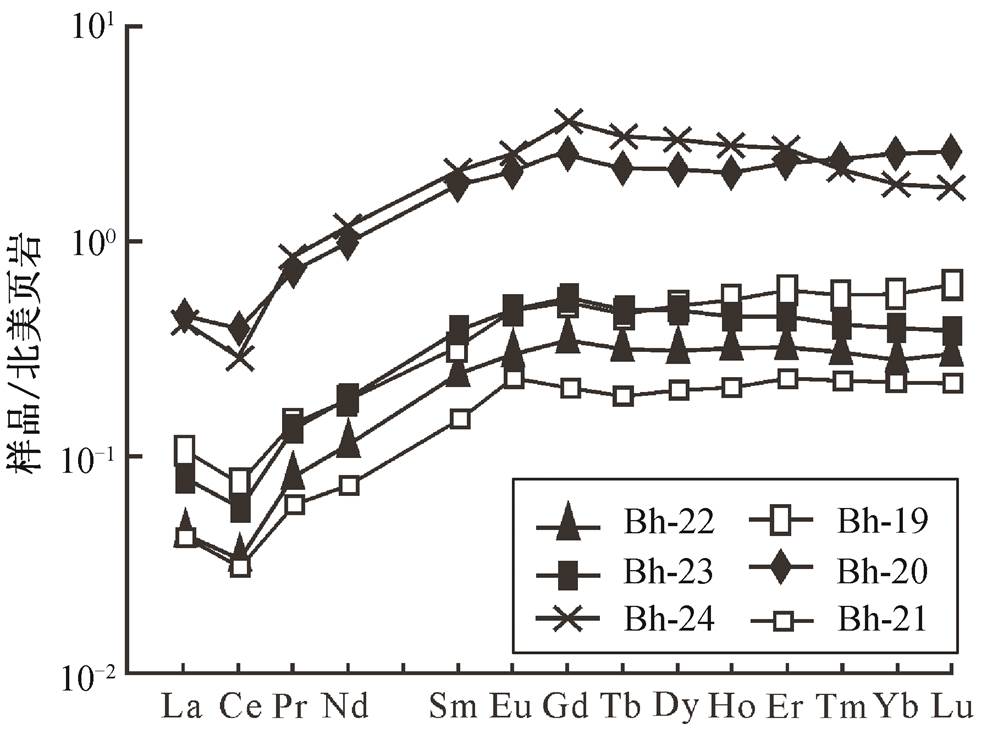
图7 坝黄剖面留茶坡组层状硅质岩稀土配分模式
Fig. 7 REE patterns of bedded chert of Liuchapo Formation in Bahuang section
稀土元素在成岩过程中较稳定[8], 是重要的地球化学指标, 其中LaN/YbN, Ce/Ce*和Eu/Eu*值可用于判别硅质岩的形成环境[10,24]。沉积硅质岩中稀土元素主要来自海水, 也可以从陆源或海底热液继承。海水的稀土元素含量很低, 稀土元素配分曲线左倾, Ce 明显负异常[8,25–26], 非热水沉积的硅质岩相应地具有这些特征。洋中脊及深海平原的硅质岩一般轻稀土亏损, 稀土配分曲线左倾; 大陆边缘相关的硅质岩则轻稀土富集, 稀土配分曲线右倾[27]。一般情况下, Eu 在海水和大洋沉积物中无明显异常, 只在两种情况下会出现 Eu 异常: 1)在与海底热液活动有关的部分洋脊盆地内发育的硅质岩中 Eu正异常; 2)陆源物质来源于成熟的古老地壳大陆边缘的硅质岩中 Eu 负异常, 陆源物质来源于未分异安山质岩浆岛弧的可能呈现 Eu 正异常[10]。热液活动参与会造成 Eu 正异常[28]。距热源越远, 受自然海水的影响就越大, 硅质岩的 Eu 正异常变得不明显, Ce 呈现负异常[29]。此外, 陆源碎屑沉积物的稀土元素含量较高, 且轻稀土富集, 所以继承陆源碎屑沉积物会造成硅质岩富集轻稀土而 Ce 无明显异常[29]。还有研究发现, 洋中脊附近硅质岩的 Ce/Ce*值为 0.30±0.13[10], 大洋盆地硅质岩的 Ce/Ce*值为0.60±0.13[10], 大陆边缘硅质岩的 Ce/Ce*值为 0.5~ 1.5[27]。
柑子坪剖面硅质岩中稀土元素总量较低(∑REE =3.75~7.24 μg/g), 重稀土富集程度较低, Ce 微弱负异常, Eu 正异常, 稀土元素配分曲线轻度左倾(与热液颗粒的稀土配分模式(图 8)相似)。这些稀土元素特征与现代海底热液硅质烟囱(明显的 Eu 异常, Ce 无异常或无明显异常[20,31])相似, 因此柑子坪剖面留茶坡组穹隆状硅质岩的成因很可能与热液沉积相关。坝黄剖面硅质岩中稀土元素总量相对较高(∑REE=20.14~248.56μg/g), 重稀土富集, Ce 负异常, Eu 无明显异常, 稀土元素配分曲线明显左倾, 与现代海洋深层海水稀土配分模式(图 8)相似。因此, 坝黄剖面留茶坡组层状硅质岩可能为正常海水沉积, 并伴随陆源碎屑输入。
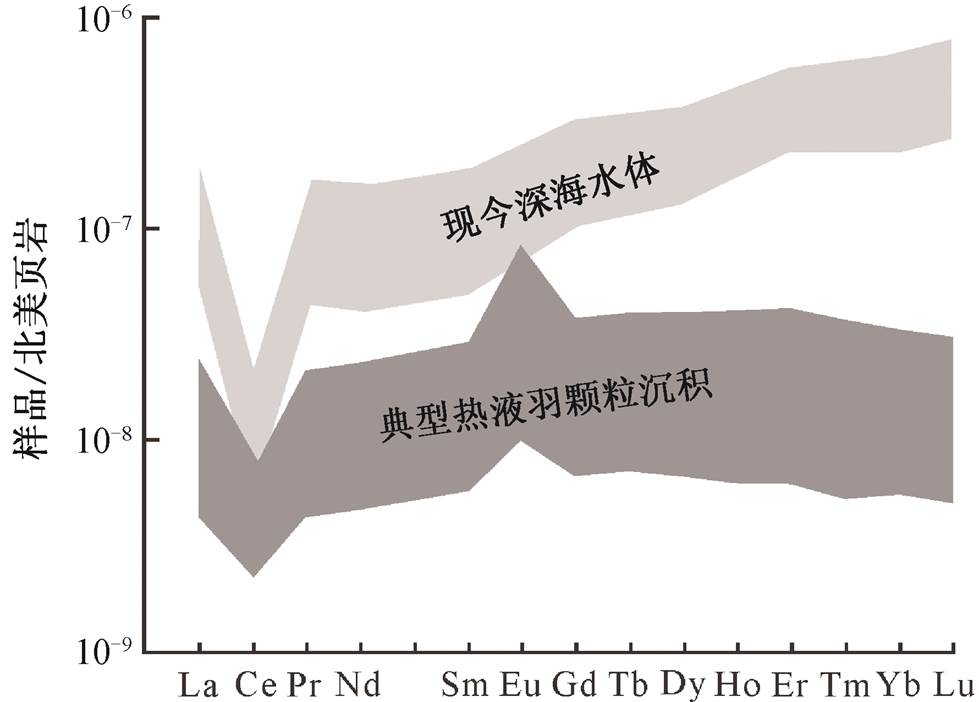
图8 现代海洋深层海水和热液颗粒物的稀土配分模式(据文献[30]修改)
Fig. 8 REE patterns of the modern deep sea water and hydrothermal plume (after Ref. [30])
大洋沉积物中稀土元素主要来源于海水吸附、陆源继承和海底火山[32]。坝黄剖面和柑子坪剖面的硅质岩为纯硅质岩, 含极少量黏土矿物, 且黏土矿物主要为含铝矿物。因此, 根据 Al2O3 与∑REE的相关性, 可以推测硅质岩的物质来源。柑子坪剖面穹隆状硅质岩中 Al2O3 与∑REE 弱相关(图 9(a)), 说明几乎没有陆源碎屑物质加入, 其物质来源为海水吸附或海底火山。坝黄层状硅质岩中 Al2O3 与∑REE 正相关(图 9(b)), 明显受到陆源碎屑的影响, 说明陆源碎屑物质对坝黄地区硅质岩的形成有主要的控制作用。
Ge/Si 值可用于反演热液体系中 Ge 和 Si 的循环[33–34], 也可推断表生环境中 Si 的来源[35]。一般来说, 海洋中的 Ge 有以下来源: 1)大陆风化产物的河流输入(Ge/Si=(0.6±0.15)×10−6)[36]; 2)海底热液流体输入(Ge/Si=(8~14)×10−6)[37]。扬子地块留茶坡组硅质岩的形成需要丰富的 Si, 但 Si 的直接来源是热液还是海水一直没有明确。目前认为, 海洋中的 Si 来自大陆风化产物, 这是因为现代海洋中Ge/Si 值较小(约为 0.72)。相反, 热液中明显富 Ge, 其 Ge/Si 值(约为 11)比海水高一个数量级[37]。因此, 利用Ge/Si值可以推断硅质岩中Si的来源。
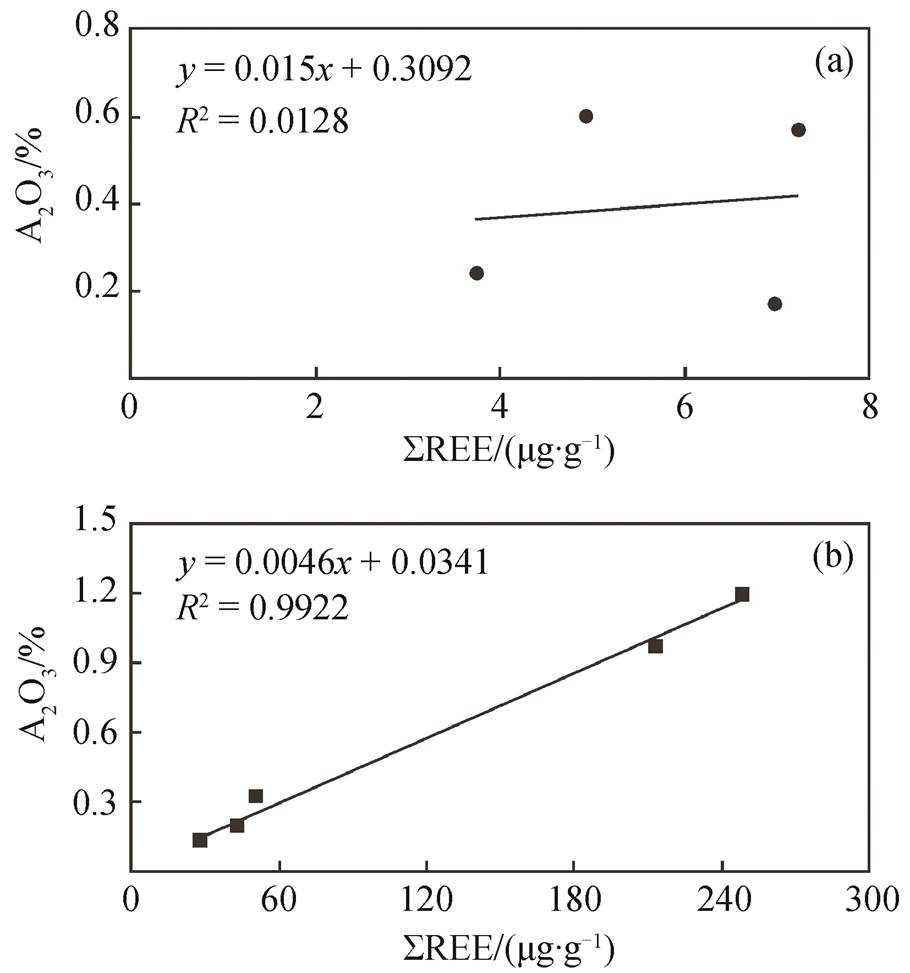
(a) 柑子坪剖面; (b) 坝黄剖面(去除样品Bh-21)
图9 硅质岩中Al2O3与∑REE的相关性
Fig. 9 Correlation between Al2O3 and ∑REE of the cherts
坝黄留茶坡组层状硅质岩的 Ge/Si值在 0.13~0.98μmol/mol 之间(平均 0.50μmol/mol), 均小于 1μmol/mol, 接近海水的 Ge/Si 值(0.72 μmol/mol), 说明 Si 的来源可能为正常海水。柑子坪留茶坡组穹隆状硅质岩的 Ge/Si 值在 1.09~1.43μmol/mol 之间(平均 1.25 μmol/mol), 均大于 1μmol/mol, 明显有热液流体的参与, 说明 Si 的来源可能为正常海水与热液混合。坝黄剖面和柑子坪剖面留茶坡组硅质岩的 Eu/Eu*值与 Ge/Si 值正相关(图 10), 基于 Eu 正、负异常与陆源、热源的关系, 推测 Ge/Si 值的大小可能也与陆源、热源有关, 可以通过模拟计算得到两者的供给比例[13]。
对埃迪卡拉纪‒寒武纪转折期不同沉积相硅质岩的物质来源已有许多研究, 基本上存在两种认识: 热液来源[19–20,38–40]和陆源风化输入(正常海水沉淀)[29]。研究发现, 埃迪卡拉纪‒寒武纪转折期热液活动分布广泛, 在扬子地块碳酸盐岩台地南缘埃迪卡拉系‒寒武系过渡地层的硅质岩中存在多期热液硅质烟囱, 直接反映硅质岩的热液成因[19,38]。汪建国等[20]发现柑子坪穹窿状硅质岩的形态、成分和结构与现代海底热液硅质烟囱有很多相似之处: 蜂窝状结构, 主要为无定形硅质, 发育大量被玉髓、白云石等充填的气孔。同时, 稀土元素含量、Ce轻微异常和 Eu 异常等特征也支持穹隆状硅质岩的热液成因。
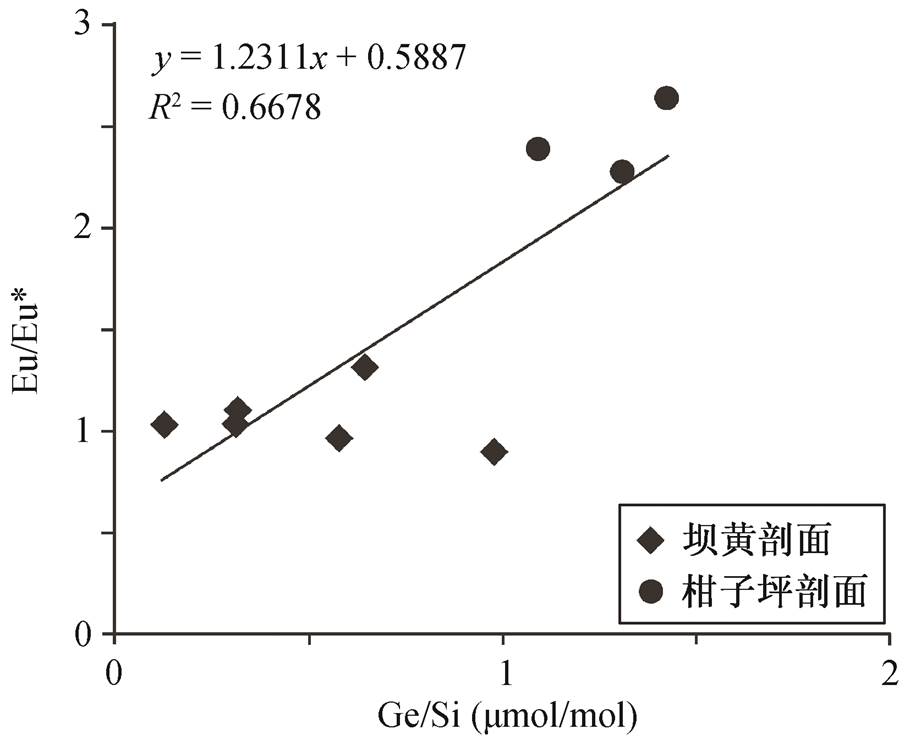
图10 坝黄剖面和柑子坪剖面硅质岩Eu/Eu*与Ge/Si的相关性
Fig. 10 Correlation between Eu/Eu* and Ge/Si of cherts in Bahuang section and Ganziping section
汪建国等[20]还在柑子坪剖面穹窿状硅质岩中发现少量尖锥形、弯月形的火山玻璃碎片, 说明附近存在明显的火山活动。古地理研究表明, 当时柑子坪地区处于台‒盆转换带上, 明显受张性同生断层控制[20,41], 因此推测穹隆状硅质岩可能是深部富Si 热液沿同生断裂向上运移至海底喷流沉淀形成的[20]。坝黄层状硅质岩处于斜坡相, 与热液喷口距离较远, 热液活动较弱, 主要受海水影响, 因此是正常海水沉淀的结果[20,29]。
如图 11(a)所示, 坝黄剖面层状硅质岩中 Ge/Si与Al2O3之间正相关, 表明高含量的Al可能对提高Ge/Si值发挥了作用。图12显示, Na, K, Sc, Co与Al之间也呈正相关关系。由于 Sc 和 Co 大多赋存于黏土矿物中, 在硅质岩中的含量很低[13], 根据 Sc和 Co 与 Al 的相关性, 推测 Al 含量很可能与黏土矿物含量有关, 而 Al 含量与 Ge/Si 值也存在相关性, 那么, 黏土矿物、Al 含量、Ge/Si 值三者存在耦合关系, 据此推测黏土矿物的含量也可能改变Ge/Si 比值。一般情况下, 黏土矿物中 Ge/Si 值很高(通常>2)[42], 我们据此解释硅质岩中 Ge/Si 与Al2O3 的相关性。坝黄剖面层状硅质岩中 Ge/Si 与Al2O3 之间正相关(图 11(a)), 说明受黏土矿物影响。由于黏土矿物多为陆源风化产物, 因此说明坝黄剖面的层状硅质岩与陆源风化关系密切。柑子坪穹隆状硅质岩中 Ge/Si 与 Al2O3 之间相关性很差(图11(b)), 且 Al2O3 含量比坝黄剖面层状硅质岩低, 说明黏土矿物含量很少, 其物质来源的陆源成分极低, 形成过程中可能有热液来源的物质参与。
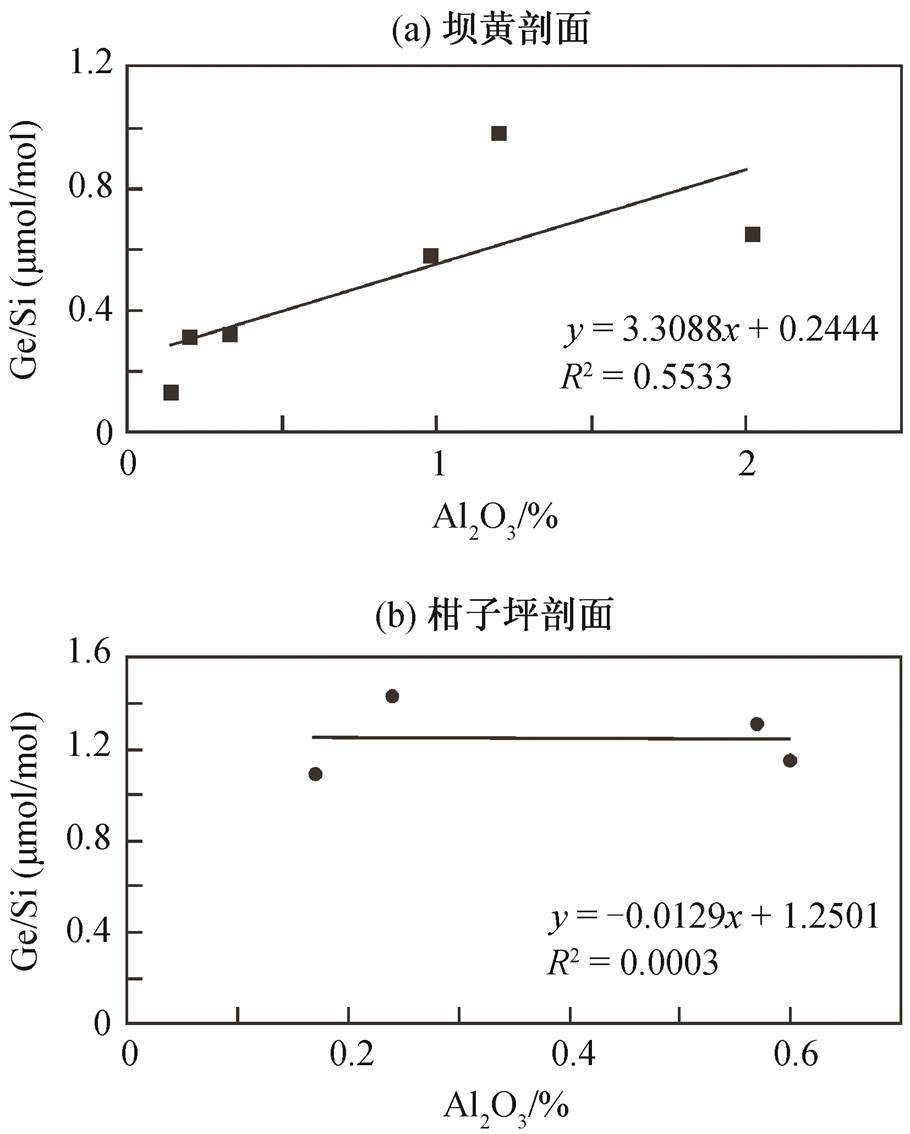
图11 硅质岩中Ge/Si与Al2O3的相关性
Fig. 11 Correlation between Ge/Si and Al2O3 of the cherts
本文对贵州坝黄层状硅质岩和湖南柑子坪穹窿状硅质岩的主、微量元素及稀土元素特征和 Ge/Si值进行了分析, 得到如下结论。
1)湖南柑子坪剖面穹窿状硅质岩贫 Al2O3, MgO, TiO2, CaO, Na2O和K2O; 贵州坝黄剖面层状硅质岩富 MgO 和 CaO, 相对富 Al2O3, 贫 TiO2, Na2O 和K2O。
2)柑子坪剖面硅质岩总稀土含量低, 稀土元素配分曲线轻微左倾, Eu明显正异常, Ce弱负异常, 重稀土富集程度低。坝黄剖面硅质岩总稀土含量高, 稀土元素配分曲线明显左倾, 无Eu异常, Ce明显负异常, 重稀土富集程度高。坝黄剖面硅质岩Al2O3 与∑REE 的相关性极好, 柑子坪剖面硅质岩Al2O3与∑REE的相关性极差。
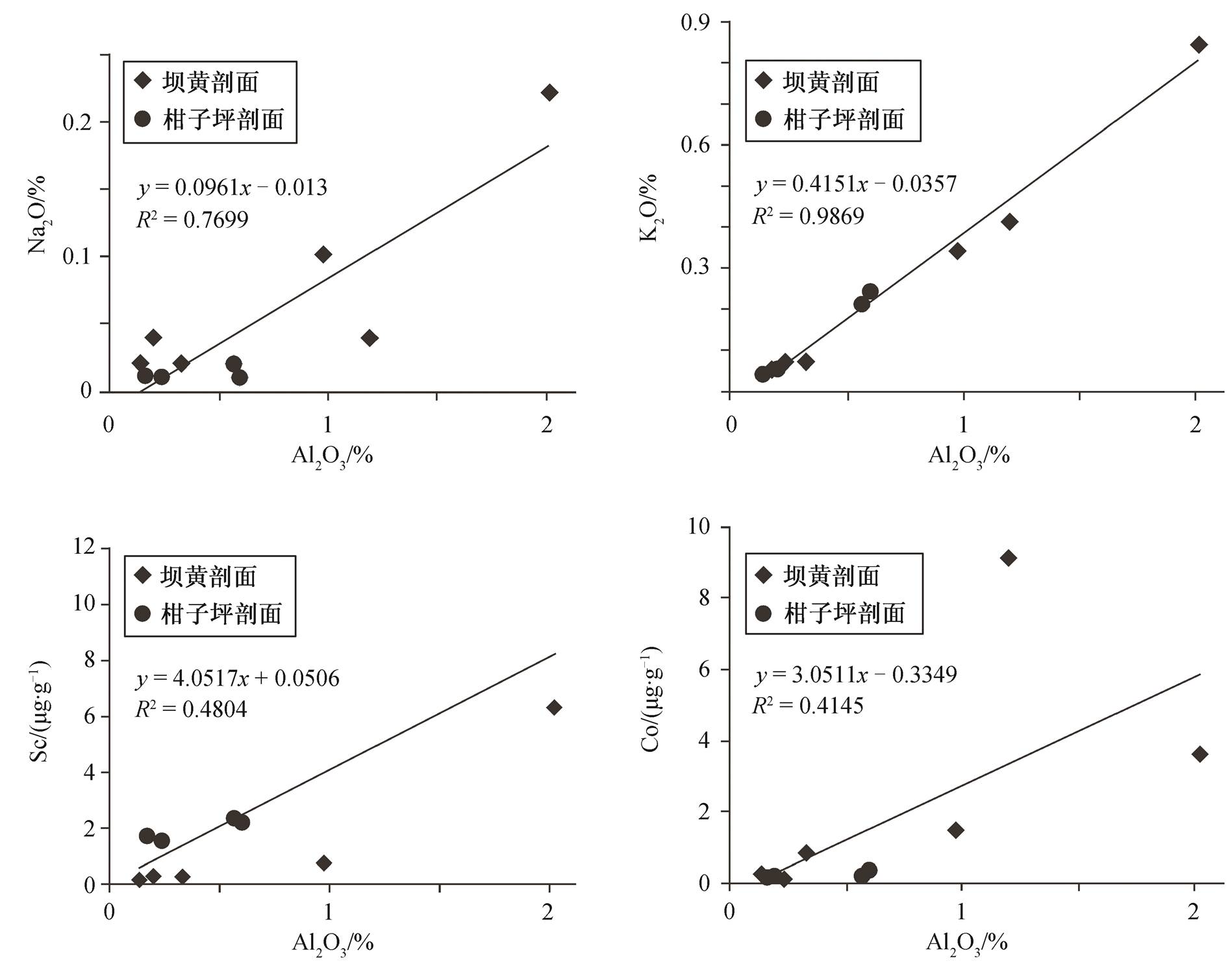
图12 坝黄剖面和柑子坪剖面硅质岩中元素之间的相关性
Fig. 12 Correlation between elements of cherts in Bahuang section and Ganziping section
3)柑子坪剖面硅质岩的 Ge/Si 值大于 1μmol/mol, 坝黄剖面硅质岩的Ge/Si值小于 1 μmol/mol。坝黄剖面层状硅质岩中 Ge/Si 值与 Al2O3 含量正相关, 且Na, K, Sc, Co与Al正相关; 柑子坪穹隆状硅质岩中Ge/Si值与Al2O3的相关性很差。
结合两种纯硅岩所处的古地理环境及地球化学特征进行综合分析, 推断穹隆状硅质岩为台缘同生断裂处因海底热液喷流而形成, 层状硅质岩处于斜坡相, 主要受海水影响, 正常沉淀而成。
致谢 感谢中国科学院地质与地球物理研究所陈代钊教授对野外工作的大力支持。
参考文献
[1]Hou X G, Aldridge R J, Bergström J, et al. The Cam-brian Fossils of Chengjiang, China: the flowering of early animal life. Oxford: Blackwell, 2004
[2]Shields-Zhou G, Och L. The case for a neoproterozoic oxygenation event: geochemical evidence and biolo-gical consequences. GSA Today, 2011, 21(3): 4‒11
[3]杨競红, 蒋少涌, 凌洪飞, 等. 黑色页岩与大洋缺氧事件的 Re-Os 同位素示踪与定年研究. 地学前缘, 2005, 12(2): 143‒150
[4]朱茂炎. 动物的起源和寒武纪大爆发: 来自中国的化石证据. 古生物学报, 2010, 49(3): 269‒287
[5]Canfield D E, Poulton S W, Knoll A H, et al. Ferru-ginous conditions dominated Later Neoproterozoic deep-water chemistry. Science, 2008, 321: 949‒952
[6]Chen D, Zhou X, Fu Y, et al. New U-Pb zircon ages of the Ediacaran-Cambrian boundary strata in South China. Terra Nova, 2015, 27(1): 62‒68
[7]Douthitt C B. The geochemistry of the stable isotopes of silicon. Geochimica et Cosmochimica Acta, 1982, 46(8): 1449‒1458
[8]陈永权, 蒋少涌, 周新源, 等. 塔里木盆地寒武系层状硅质岩与硅化岩的元素、δ30Si、δ18O地球化学研究. 地球化学, 2010, 39(2): 159‒170
[9]Murray R W, Brink M R B T, Gerlach D C, et al. Rare earth, major, and trace element composition of Mon-terey and DSDP chert and associated host sediment: assessing the influence of chemical fractionation during diagenesis. Geochimica et Cosmochimica Acta, 1992, 56(7): 2657‒2671
[10]黄华, 王国芝. 浙黔桂地区寒武纪硅质岩的地球化学特征及其形成背景. 沉积与特提斯地质, 2011, 31(1): 100‒106
[11]Frei R, Polat A. Source heterogeneity for the major components of ~3.7 Ga banded iron formations (Isua Greenstone belt, Western Greenland): tracing the na-ture of interacting water masses in BIF formation. Earth and Planetary Science Letters, 2007, 253(1/2): 266‒281
[12]Delvigne C, Cardinal D, Hofmann A, et al. Stratigra-phic changes of Ge/Si, REE+Y and silicon isotopes as insights into the deposition of a Mesoarchaean banded iron formation. Earth and Planetary Science Letters, 2012, 355/356: 109‒118
[13]Shen B, Lee C A, Xiao S. Germanium/silica ratios in diagenetic chert nodules from the Ediacaran Dou-shantuo Formation, South China. Chemical Geology, 2011, 280(3/4): 323‒335
[14]Dong L, Shen B, Lee C A, et al. Germanium/silicon of the Ediacaran-Cambrian Laobao cherts: implications for the bedded chert formation and paleoenvironment interpretations. Geochemistry Geophysics Geosys-tems, 2015, 16(3): 751‒763
[15]Alibert C, Kinsley L. Ge/Si in Hamersley BIF as tracer of hydrothermal Si and Ge inputs to the Paleoproterozoic ocean. Geochimica et Cosmochimica Acta, 2016, 184: 329‒343
[16]Wang C, Wu H, Li W, et al. Changes of Ge/Si, REE+Y and Sm-Nd isotopes in alternating Fe- and Si-rich mesobands reveal source heterogeneity of the ~2.54 Ga Sijiaying banded iron formation in Eastern Hebei, China. Ore Geology Reviews, 2016, 80: 363‒376
[17]夏文杰, 杜森官, 徐新煌, 等. 中国南方震旦纪岩相古地理与成矿作用. 北京: 地质出版社, 1994
[18]Yeasmin R, Chen D, Fu Y, et al. Climatic-oceanic forcing on the organic accumulation across the shelf during the Early Cambrian (age 2 through 3) in the mid-upper Yangtze Block, NE Guizhou, South China. Journal of Asian Earth Sciences, 2017, 134: 365‒386
[19]Chen D, Wang J, Qing H, et al. Hydrothermal venting activities in the Early Cambrian, South China: petro-logical, geochronological and stable isotopic con-straints. Chemical Geology, 2009, 258(3): 168‒181
[20]汪建国, 陈代钊, 严德天, 等. 湘西地区前寒武纪‒寒武纪转折期碳酸盐‒硅泥质沉积体系的截然转换: 地层‒沉积样式形成机理及意义. 地质科学, 2011, 46(1): 27‒41
[21]Adachi M, Yamamoto K, Sugisaki R. Hydrothermal chert and associated siliceous rocks from the northern Pacific their geological significance as indication of ocean ridge activity. Sedimentary Geology, 1986, 47 (1): 125‒148
[22]Herzig P M, Becker K P, Stoffers P, et al. Hydro-thermal silica chimney fields in the Galapagos Sprea-ding Center at 86°W. Earth and Planetary Science Letters, 1988, 89(3): 261‒272
[23]McLennan S M. Rare earth elements in sedimentary rocks: influence of provenance and sedimentary pro-cess. Reviews in Mineralogy and Geochemistry, 1989, 21(1): 169‒200
[24]彭军, 夏文杰, 伊海生. 湘西晚前寒武纪层状硅质岩的热水沉积地球化学标志及其环境意义. 沉积与特提斯地质, 1999, 19(2): 29‒37
[25]Murray R W, Gerlach D C, Iii G P R, et al. Rare earth, major, and trace elements in chert from the Franciscan complex and Monterey group, California: assessing REE sources to fine-grained marine sediments. Geo-chimica et Cosmochimica Acta, 1991, 55(7): 1875–1895
[26]Bolhar R, Kamber B S, Moorbath S, et al. Charac-terisation of early Archaean chemical sediments by trace element signatures. Earth and Planetary Science Letters, 2004, 222(1): 43‒60
[27]Armstrong H A, Owen A W, Floyd J D. Rare earth geochemistry of Arenig cherts from the Ballantrae Ophiolite and Leadhills Imbricate Zone, southern Scotland: implications for origin and significance to the Caledonian Orogeny. Journal of the Geological Society, 1999, 156(3): 549‒560
[28]Dias Á S, Früh-Green G L, Bernasconi S M, et al. Geochemistry and stable isotope constraints on high-temperature activity from sediment cores of the Saldanha hydrothermal field. Marine Geology, 2011, 279: 128‒140
[29]张亚冠, 杜远生, 徐亚军, 等. 湘中震旦纪‒寒武纪之交硅质岩地球化学特征及成因环境研究. 地质论评, 2015, 61(3): 499‒510
[30]Slack J F, Grenne T, Bekker A, et al. Suboxic deep seawater in the late Paleoproterozoic: evidence from hematitic chert and iron formation related to seafloor-hydrothermal sulfide deposits, central Arizona, USA. Earth and Planetary Science Letters, 2007, 255(1/2): 243‒256
[31]German C R, Klinkhammer G P, Edmond J M, et al. Hydrothermal scavenging of rare-earth elements in the ocean. Nature, 1990, 345: 516‒518
[32]遇昊, 陈代钊, 韦恒叶, 等. 鄂西地区上二叠乐平统大隆组硅质岩成因及有机质富集机理. 岩石学报, 2012, 28(3): 1017‒1027
[33]Evans M J, Derry L A. Quartz control of high germanium/silicon ratios in geothermal waters. Geo-logy, 2002, 30: 1019‒1022
[34]Hammond D E, Mcmanus J, Berelson W M. Oceanic germanium/silicon ratios: evaluation of the potential overprint of temperature on weathering signals. Pa-leoceanography, 2004, 19(2): 399‒420
[35]Kurtz A C, Derry L A, Chadwick O A. Germanium-silicon fractionation in the weathering environment. Geochimica et Cosmochimica Acta, 2002, 66(9): 1525‒1537
[36]Froelich P N, Blanc V, Mortlock R A, et al. River fluxes of dissolved silica to the ocean were higher during glacials: Ge/Si in diatoms, rivers, and oceans. Paleoceanography, 1992, 7(6): 739–767
[37]Mortlock R A, Froelich P N, Feely R A, et al. Silica and germanium in Pacific Ocean hydrothermal vents and plumes. Earth and Planetary Science Letters, 1993, 119(3): 365‒378
[38]Wang J, Chen D, Wang D, et al. Petrology and geo-chemistry of chert on the marginal zone of Yangtze Platform, western Hunan, South China, during the Ediacaran-Cambrian transition. Sedimentology, 2012, 59(3): 809–829
[39]Fan H, Wen H, Zhu X, et al. Hydrothermal activity during Ediacaran-Cambrian transition: silicon isoto-pic evidence. Precambrian Research, 2013, 224: 23‒ 35
[40]江永宏, 李胜荣. 湘、黔地区前寒武‒寒武纪过渡时期硅质岩生成环境研究. 地学前缘, 2005, 12(4): 622‒629
[41]陈代钊, 汪建国, 严德天, 等. 中扬子地区早寒武世构造‒沉积样式与古地理格局. 地质科学, 2012, 47(4): 1052‒1070
[42]Rouxel O, Galy A, Elderfield H. Germanium isotopic variations in igneous rocks and marine sediments. Geochimica et Cosmochimica Acta, 2006, 70(13): 3387‒3400
Origin of Cherts during the Ediacaran-Cambrian Transition in Hunan and Guizhou Provinces, China:Evidencesfrom REE and Ge/Si
WEI Shuaichao1,2, CHEN Qifei3, FU Yong1,4,†, CUI Tao5, LIANG Houpeng1, GE Zhihua1, ZHANG Peng1, ZHANG Yong6
1. School of Resources and Environments, Guizhou University, Guiyang 550025; 2. Institute of Hydrogeology and Environmental Geology, Chinese Academy of Geological Sciences, Shijiazhuang 050061; 3. Guizhou Geological Survey, Guiyang 550018; 4. Institute of Mineral Resources, Chinese Academy of Geological Sciences, Beijing 100037; 5. College of Resources and Environmental Engineering, Guizhou Institute of Technology, Guiyang 550003; 6. Jiangsu Electric Power Design Institute, Nanjing 211102; † Corresponding author, E-mail: byez1225@126.com
Abstract Two types of Liuchapo Formation cherts, bedded cherts and mounded cherts, were deposited in Bahuang section of Tongren in Guizhou Province and Ganziping section of Zhangjiajie in Hunan Province. The origin of the cherts was discussed by analyzing the characteristics of major, trace elements and REE compositions and Ge/Si ratios. It was revealed that the content of SiO2 in bedded cherts was range from 96.06% to 99.61%, and the content of SiO2 in mounded cherts was range from 98.62% to 99.56%, averaging 99.13%, and the contents of other chemical components were very low. Thus, two types of cherts are pure cherts. Moreover, the ∑REE of the bedded cherts in Bahuang section is ranged from 20.14 to 248.56μg/g (averaging 100.62μg/g), and no obvious abnormality in Eu/Eu* which is ranged from 0.90 to 1.10 (averaging 1.06), and the ratio of Ge/Si is 0.13-0.98 μmol/mol (averaging is 0.50μmol/mol), indicating that the origin of bedded cherts affected terrigenous input. Whereas, the ∑REE of the mounded cherts in Ganziping district is ranged from 3.75 to 7.24μg/g (averaging 5.73μg/g), the ratio of Ce/Ce* is 0.46-0.66 (averaging 0.57) which shows a negative abnormal, Eu/Eu* is ranged from 2.28 to 11.07 (averaging 4.60) which shows a positive abnormal, and Ge/Si ratio is 1.09-1.43 μmol/mol, (averaging 1.25 μmol/mol) all of which reflect a hydrothermal origin of the mounded cherts. Otherwise, the relationship between Al2O3 and ∑REE in the bedded cherts has an excellent correlation, while in the mounded cherts has a poor correlation. It also illustrates that continental substance plays an important role in controlling the formation of bedded cherts, and the mounded cherts is originated from submarine volcanic or hydrothermal activity. The relationship between Al2O3 and Ge/Si also reflect the origin of cherts. Combined with the paleogeographic environment, it can conclude that the mounded cherts were deposited in syngenetic fault at the margin of the basin, originated from submarine hydrothermal activity, while the bedded cherts were deposit in the deep basin, mainly influenced by terrigenous input. What’s more, using 1 μmol/mol as the critical value of Ge/Si may provide a new way to trace the material sources of cherts.
Key words Liuchapo Formation; bedded cherts; mounded cherts; Ge/Si; hydrothermal
中图分类号 P581; P594
doi: 10.13209/j.0479-8023.2018.035
国家自然科学基金(41763006)、国家重点研发计划(2017YFC0602701)和贵州省科学技术基金( LH[2014]7358)资助
收稿日期: 2017-05-23;
修回日期: 2017-11-06;
网络出版日期: 2018-05-30